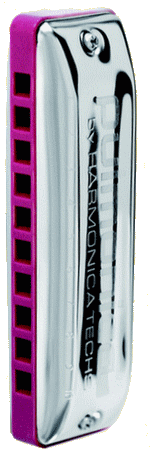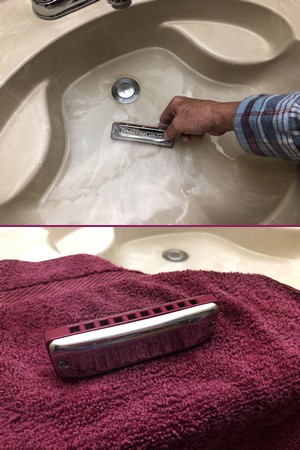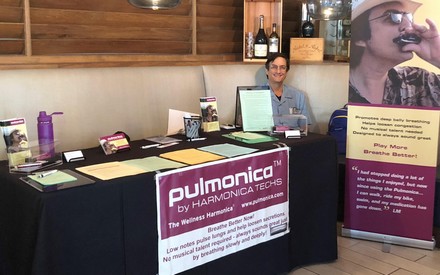The Pulmonica®
Wellness Program
 If you are under a physician’s care for any lung disorder, including COPD or asthma, check with that physician before adding the Pulmonica to your daily regimen.
If you are under a physician’s care for any lung disorder, including COPD or asthma, check with that physician before adding the Pulmonica to your daily regimen.- Hold the Pulmonica up to your mouth on the side with the 10 numbered holes. Then breathe slowly and deeply, in and out. You will sound great by simply breathing. No musical skill is needed.
- Breathe deeply through the lowest numbered holes you can manage comfortably. Do this as often as possible for best results. The more you play, the better you’ll breathe and feel.
- Carry the Pulmonica with you and use it anywhere you can talk. The pleasing sounds should be fine with those around you, in fact, you may get offered a tip. The Pulmonica is a great way to fill “wait time” during commercials, at the computer, in a store, or any other time you need something to do while you’re waiting. If anyone asks, tell them you’re playing to improve your lung health.
- The lower pitch notes (single holes 1 to 4) and chords (multiple holes played at the same time) require more air and force than the higher ones. Although higher chords require less air, lower chords deliver stronger energy pulses to your lungs and sinuses. You might need to start by playing higher chords and work into playing lower chords over several weeks.
- Remember to breathe from your belly. Try lying on your back with a hand on your stomach and feel it rise and fall. That is also called abdominal breathing or diaphragmatic breathing, and is an important component of respiratory therapy and physical wellness.
- If your throat gets dry during use, try inhaling through your nose and exhaling through the Pulmonica. When not using the Pulmonica, breathe through your nose to filter and moisten the air before it reaches your lungs.
- Play sitting down until you have experience. You might feel light-headed at first. If you feel light-headed, stop playing and remain seated until feeling normal. Try again in a few minutes playing more slowly or on higher notes that don’t require as much air, then work your way down to the lower notes over a few weeks or months.
- When you inhale or exhale through a Pulmonica, don't use too much force. The Pulmonica has a built-in guide. If the reed buzzes on inhaling with low notes, you are breathing too hard.
- Remember to use good posture and keep your neck and shoulders straight as you play.
- Use water to keep your mouth and lips moist.
- Be aware of your environment when you play because you will be breathing deeply. For example, do not play outside during pollen season. Play where air is clean, such as in air conditioning.

- The Pulmonica is best used in combination with a pulmonary rehabilitation or respiratory support group, such as the American Lung Association’s Better Breathers Clubs. Ask your physician for a referral, or look online for a local group. More information on what to expect in a pulmonary rehabilitation program is listed below.
- To keep track of your progress, make a note of how long you play each day and how many seconds you can inhale and exhale. A standard test used by lung doctors is how far you can walk in six minutes, so you might try that periodically. You can download our convenient Progress PDF, or keep a notebook.
- Try making sounds other than just breathing. Try chugging like a train and use the higher notes to make the whistle. You can also try saying the alphabet, counting to 100, singing a song, or whatever your imagination can think up. Remember to use long deep breaths for optimal wellness. Use our MP3s to guide you. Please send us a comment at Pulmonica.com if you come up with an interesting sound.
- You can play in rhythm with your favorite music or a metronome. It doesn’t matter if you’re exact, the Pulmonica always sounds good.
- If you want to try playing some simple tunes, download our MP3s and the sheet music and play along. Some people like to learn one song so they can impress their friends and family.
- Playing any harmonica is good for your lungs to some extent, and we hope some people will learn to love the instrument for its musicality. There are a lot of free lessons online, just search for ‘free harmonica lessons’. The Pulmonica is tuned to the key of ‘G’ for folk and country music.
- Print your Progress Chart:
ProgressChart.pdf
ProgressChart.doc
Pulmonica Audio Files and Sheet Music
- Hear Pulmonica Music and View Pulmonica Sheet Music:
Music files
PulmonicaSongs.pdf
Pulmonica Care

- Do not share your Pulmonica.
- Have a clean mouth before playing to avoid food particles stopping reeds from properly functioning. Do not drink sugary fluids before or during playing.
- Dampen a soft cloth with water to clean stainless steel covers as often as needed.
- Let your Pulmonica dry after each use before putting it away. Place it on a clean towel so that the holes are facing upwards to drain and dry.
- To rinse the inside, gently swish your Pulmonica in diluted mouthwash or plain water in a bowl or sink followed by clean water, and let it dry thoroughly.
- Do not place your Pulmonica under running water or use electric hair dryers, as doing so can damage reeds.
- Do not ‘leg-slap’ the Pulmonica to drain it of moisture. Due to the special reeds required for proper function, this action can cause damage to the reeds.
- Warm your Pulmonica to body temperature before playing to extend reed life. If you are in a cold place, hold the Pulmonica in your hands for a few minutes or keep it in your pocket to keep it warm.
To Sanitize the Pulmonica
- To sanitize the Pulmonica: submerge in 70%-90% isopropyl alcohol for five minutes or more, or 3% hydrogen peroxide for 30 minutes or more, then rinse the Pulmonica in sterile water in a clean bowl by submerging, gently moving around, and lifting the Pulmonica to drain, repeating a few times, and then let the Pulmonica thoroughly air dry for several hours. Remember: do not hold the Pulmonica under running water, ‘leg slap’ it, or blow-dry it, as these actions can damage the reeds. Since consumer disassembly and reassembly can damage the reeds, submerge the fully assembled Pulmonica.
Pulmonica Safety Information
- Safe for ages three (3) and older.
- Sit down if dizzy from playing.
- Do not use if you have pneumothorax, advanced TB, lung pain, or are coughing up blood.
Respiratory Therapy Basics

- Breathe deeply from your belly. If you’re not sure if you’re belly breathing, lie down with a hand on your stomach and breathe deeply through your nose. Your stomach should rise and fall. Keep practicing until this is natural all the time. Shallow breathing doesn’t let enough oxygen get to your vital organs. Pursing your lips when you exhale provides gentle resistance and strengthens your diaphragm. Using the Pulmonica daily will help make deep breathing a habit, providing gentle resistance and relaxing, meditative sounds.
- Exercise as much as possible, again to get that oxygen and blood flowing. Try to do something active every day, and break a sweat four or five times a week. Lifting weights and staying strong now will help you stay independent later. The lungs are dependent on the diaphragm and chest muscles to work properly, so muscle strength is vital to lung function. Search online for pulmonary rehabilitation or respiratory therapy exercises.
- Take medications correctly as prescribed by your doctor.
- Avoid triggers that can make respiratory disorders worse such as: air pollution, cigarette smoke, very cold or very humid air, pollen, dust, animal dander and fragrances. You have a right to clean air, so politely tell people that smoke, perfumes, or animals make you sick. Even the residual scent and dander on people’s clothes can be a trigger. Put a sign on your door so visitors are forewarned.
- Use good posture to keep airways open, especially while using nebulizer, inhaler, or Pulmonica.
- Get a flu vaccine every year and get a pneumonia vaccination every five years.
- Avoid sick people.
- Eat healthy foods in small quantities. Lose weight if necessary to make breathing easier. Smaller meals put less pressure on your diaphragm.
- Drink plenty of water. Staying hydrated will keep your secretions easier to cough up.
- Get enough sleep. Your body is under a lot of stress.
- Clear sputum with deep coughing, the cough and huff technique, or the Pulmonica. Examine sputum for changes in color or amount, and contact your doctor if you become sick.
- Find emotional support. It’s tough having COPD, asthma, or other impaired lung function. Talk to a doctor or counselor about anxiety or depression, and join a support group such as the American Lung Association's Better Breathers Club.
- The COPD Foundation has a program called Harmonicas for Health that many Better Breathers Clubs are using each month after the regular meeting. See Harmonicas for Health | COPD Foundation for more details.
- Innovative wellness starts with taking control of your health as much as possible, and that includes respiratory therapy for those who need it.